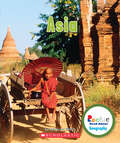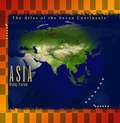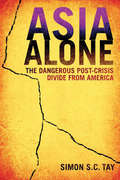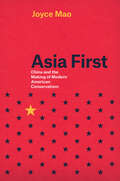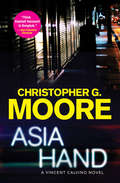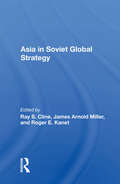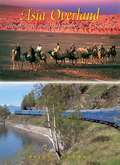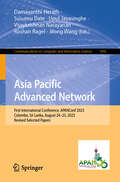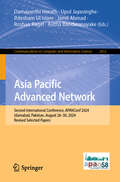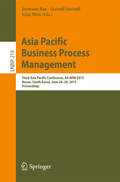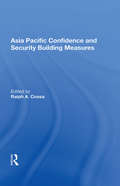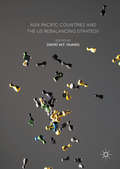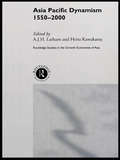- Table View
- List View
Asia (Rookie Read-About Geography: Continents)
by Rebecca Hirsch Roman CybriwskyAn introduction to Asia, focusing on its geographical features and points of interest. <P><P>Rookie Read-About: Continents series gives the youngest reader (Ages 3-6) an introduction to the components that make each continent distinctive and exceptional. Readers will get to know each continents' geography, history, and wildlife. <P><P>Lexile Measure: 410
Asia (Rookie Read-About Geography: Continents)
by Rebecca HirschAn introduction to Asia, focusing on its geographical features and points of interest.Rookie Read-About: Continents series gives the youngest reader (Ages 3-6) an introduction to the components that make each continent distinctive and exceptional. Readers will get to know each continents' geography, history, and wildlife.
Asia (The Atlas of the Seven Continents)
by Wendy VierowAtlas of the Seven Continents contains amazing continental maps and detailed information on population, beliefs, climate and vegetation, ecology and environment, economy, and politics and history. This is the best book for Geography class and for anyone who need information about any continent on Earth. Describes the continents in great detail!
Asia Alone
by Tay Simon S. C.An insightful examination of the changing relationship between Asia and the United States In this lucidly written and thought-provoking book, author Simon Tay highlights the accelerating trends that point to Asia increasingly forging its own path, independent of the United States. He also describes the fundamental changes and new policy directions needed to maintain and strengthen the bonds between Asia and the United States that have been beneficial to both since the end of the Second World War. On the eve of the global financial crisis of 2008, the economies of the United States and its Asian partners were deeply interdependent. But the different approaches taken to the crisis by Asian and Western leaders point to a new separation that may have negative consequences for the economies and businesses of both regions. To avoid a dangerous divide that may make us all the poorer, Tay reveals what leaders, policy-makers, companies, and citizens can do to find a balance that enriches us all. Written by a leading public intellectual CNN's Fareed Zakaria describes as "one of the most intelligent and reliable guides to the region" Touches on major issues in foreign policy and economics that will impact Asian nations and the United States over the near future Explains the changing nature of economic relations in the global economy For foreign policy followers, politicians, and businesspeople, Asia Alone charts a path forward--together.
Asia First: China and the Making of Modern American Conservatism
by Joyce MaoAfter Japanese bombs hit Pearl Harbor, the American right stood at a crossroads. Generally isolationist, conservatives needed to forge their own foreign policy agenda if they wanted to remain politically viable. When Mao Zedong established the People’s Republic of China in 1949--with the Cold War just underway--they had a new object of foreign policy, and as Joyce Mao reveals in this fascinating new look at twentieth-century Pacific affairs, that change would provide vital ingredients for American conservatism as we know it today. Mao explores the deep resonance American conservatives felt with the defeat of Chiang Kai-Shek and his exile to Taiwan, which they lamented as the loss of China to communism and the corrosion of traditional values. In response, they fomented aggressive anti-communist positions that urged greater action in the Pacific, a policy known as "Asia First. ” While this policy would do nothing to oust the communists from China, it was powerfully effective at home. Asia First provided American conservatives a set of ideals--American sovereignty, selective military intervention, strident anti-communism, and the promotion of a technological defense state--that would bring them into the global era with the positions that are now their hallmark.
Asia First: China and the Making of Modern American Conservatism
by Joyce MaoAfter Japanese bombs hit Pearl Harbor, the American right stood at a crossroads. Generally isolationist, conservatives needed to forge their own foreign policy agenda if they wanted to remain politically viable. When Mao Zedong established the People’s Republic of China in 1949—with the Cold War just underway—they had a new object of foreign policy, and as Joyce Mao reveals in this fascinating new look at twentieth-century Pacific affairs, that change would provide vital ingredients for American conservatism as we know it today. Mao explores the deep resonance American conservatives felt with the defeat of Chiang Kai-Shek and his exile to Taiwan, which they lamented as the loss of China to communism and the corrosion of traditional values. In response, they fomented aggressive anti-communist positions that urged greater action in the Pacific, a policy known as “Asia First.” While this policy would do nothing to oust the communists from China, it was powerfully effective at home. Asia First provided American conservatives a set of ideals—American sovereignty, selective military intervention, strident anti-communism, and the promotion of a technological defense state—that would bring them into the global era with the positions that are now their hallmark.
Asia Hand (The Vincent Calvino Novels #2)
by Christopher G. MooreChristopher G. Moore’s prize-winning series of Bangkok thrillers featuring Vincent Calvino, a disbarred American lawyer turned PI, have been praised for their captivating plots, engaging characters, and insight into the steamy Thai capital. In Asia Hand, the second novel in the series, Bangkok is celebrating Chinese New Year when Calvino’s revels are cut short. The body of an American, an acquaintance of Calvino’s, has been fished out of the lake in Lumpini Park. Around his neck are a string of wooden amulets, the kind upcountry Thais wear to protect themselves from evil spirits. Only rather than saving Hutton, these have killed him.A freelance cameraman scraping by on the margins, Hutton had photographed something shortly before his death that he thought would make his career. Now the footage-a shocking execution on the Thai/Burmese border-is running repeatedly on CNN, and the rights to Hutton’s life story have been sold to a Hollywood producer. But who killed Hutton and why? When Calvino investigates, he collides with a powerful filmmaker and an experienced old Asia hand who knows the terrain as well as our man in Bangkok. It’s all Calvino can do to stay alive, and find out who killed his fellow American.
Asia Home
by Michael FreemanThe global exchange of design and taste is at its most fertile between Asia and the West. Leading Asian designers and architects have reprocessed international ideas and functionality into the idiom of Asian cultures, from India to China, Japan to Southeast Asia. Asia Home is a wide-ranging look at contemporary design from across the region, featuring more than 100 homes and more than 50 top designers.
Asia In Soviet Global Strategy
by Roger E. Kanet Ray S. Cline James Arnold MillerThis book, the final report of the Soviet Global Strategy Project, describes the USSR's basic approach to the many states in Asia and the Pacific Basin, including nations stretching from Japan to Australia.
Asia Inside Out: Changing Times
by Eric TagliacozzoThe first of three volumes surveying the historical, spatial, and human dimensions of inter-Asian connections, Asia Inside Out: Changing Times brings into focus the dynamic networks that have linked peoples from Japan to Yemen over the past five centuries. Each author examines a single year or decade that redefined Asia.
Asia Inside Out: Connected Places
by Helen F. Siu Eric Tagliacozzo Peter C. PerdueAsia Inside Out reveals the dynamic forces that have historically linked regions of the world’s largest continent, stretching from Japan and Korea to the South China Sea, the Indian Ocean, and the Middle East. <P><P>Connected Places, the second installment in this pioneering three-volume survey, highlights the transregional flows of goods, ideas, and people across natural and political boundaries―sea routes, delta ecologies, and mountain passes, ports and oasis towns, imperial capitals and postmodern cities. It challenges the conventional idea that defines geopolitical regions as land-based, state-centered, and possessing linear histories.
Asia Inside Out: Itinerant People
by Eric TagliacozzoIn the final volume of Asia Inside Out, a stellar interdisciplinary team of scholars shows the ways that itinerant groups criss-crossing the continent have transformed their culture and surroundings. Going beyond time and place, which animated the first two books, this third one looks at human beings on the move.
Asia Light: Healthy & fresh South-East Asian recipes
by James GhillieAsian ingredients are fresh, vibrant and renowned for their health benefits, but Asian recipes often aren't as healthy as they seem because of their use of lots of sugar, salt, unhealthy oils and fatty cuts of meat. Asia Light offers nutritious and lower fat ways of cooking classic dishes, such as Vietnamese Spring Rolls, Laksa and Beef Rendang, as well as Ghillie's own creations, including Steam Baked Salmon and Vegetable Parcels with Asian Dressing and Vietnamese Chocolate Coffee Pots. These recipes are packed with superfood ingredients and have the traditional South East Asian balance of hot, sour, salty and sweet. With chapters on: Starters; Soups; Salads; Rice & Noodles; Baked, BBQ and One Pot; Stir-fries; Curries; Ices, Coolers, Cocktails & Sweet Treats; plus a bonus Basics section on how to make more healthy versions of South-East Asian pastes and sauces, this is a cookbook that can be used every day and by anybody.
Asia Light: Healthy & fresh South-East Asian recipes
by James GhillieAsian ingredients are fresh, vibrant and renowned for their health benefits, but Asian recipes often aren't as healthy as they seem because of their use of lots of sugar, salt, unhealthy oils and fatty cuts of meat. Asia Light offers nutritious and lower fat ways of cooking classic dishes, such as Vietnamese Spring Rolls, Laksa and Beef Rendang, as well as Ghillie's own creations, including Steam Baked Salmon and Vegetable Parcels with Asian Dressing and Vietnamese Chocolate Coffee Pots. These recipes are packed with superfood ingredients and have the traditional South East Asian balance of hot, sour, salty and sweet. With chapters on: Starters; Soups; Salads; Rice & Noodles; Baked, BBQ and One Pot; Stir-fries; Curries; Ices, Coolers, Cocktails & Sweet Treats; plus a bonus Basics section on how to make more healthy versions of South-East Asian pastes and sauces, this is a cookbook that can be used every day and by anybody.
Asia Literacy in a Global World: An Australian Perspective (Education in the Asia-Pacific Region: Issues, Concerns and Prospects #45)
by Hannah Soong Nayia CominosThis book is particularly timely in light of continuing international efforts to integrate Asia literacy into a national educational system where understanding of Asia – its languages, cultures, histories, and beliefs – is still at an emergent stage for a nation that is evolving into what George Megalogenis refers as ‘an Eurasian society’ (2015).The contributors to this collection range from the pioneers who created and developed the Asia literacy research space, to those who bring additional new theoretical insights through disciplines such as linguistics and ethnography. Their analysis has resulted in recommendations to develop a deeper understanding of working and living in diverse communities. The book also brings together theoretical perspectives on the current Australian socio-cultural and political context and how that can impact on pedagogical advancement in Asia literacy.The book argues for a broadening focus on what the outcomes Asia literacy in a global world can be for all Australians and offers counter narratives to the myth of a homogenous ‘White Australian culture’, to provide new ways of engaging with curriculum and pedagogy that transcend superficial awareness of multiculturalism to embrace realistic and reflective principles of global education.
Asia Literate Schooling in the Asian Century (Routledge Series on Schools and Schooling in Asia)
by Christine HalseGlobalization, migration, transnational movements and the development of the tiger economies of Asia have led education leaders and policy makers around the world but particularly in Australia, the USA, Canada, and New Zealand to view schools as key sites for developing ‘globally competent’, ‘Asia literate’ citizens who have the capabilities to live, work and interact with the peoples, cultures and societies of Asia. In what has been dubbed the ‘Asian Century’, nations are increasingly seeking to transform their schooling policies, curricula, and teaching workforces to engage with the growing influence of the peoples, cultures and societies both within and beyond Asia. This is the first book to subject to critical scrutiny and analysis the concepts, policies and practices of schooling involved in building intercultural relations with the diverse contemporary manifestations of ‘Asia’. It brings into dialogue scholars who are at the forefront of current thinking, policy and practice on Asia-related schooling, and contributes to a broader, international debate about the future shape of intercultural schooling in a global world. Asia Literate Schooling in the Asian Century offers chapters on: • Learning Asia: In search of a new narrative • Asia Literacy as Experiential Learning • Professional Standards and Ethics in Teaching Asia Literacy • The Feasibility of Implementing Cross-Curricular Studies of Asia • Deparochialising Education and the Asian Priority: A Curriculum (Re)Imagination This book will appeal to scholars and practitioners in Education, and is suitable as a reference for teacher education courses. It will also interest scholars specialising in Asian Studies.
Asia Overland: Tales of Travel on the Trans-Siberian & Silk Road
by Bijan OmraniThe story of travel through the centuries along Eurasia's great land routes, told through the observations and accounts of many of the world's great travelers, and enhanced by wonderful illustrations both old and new. What was it really like to travel the iron rails of the Trans-Siberian Railway in its early years, the dusty, parched tracks of the Silk Road in its heyday, or the rugged, dangerous mountain passes into and out of the Indian subcontinent? Eurasia's great land routes, offspring of the ambition of Russian tsars, Chinese emperors and Mughal khans, have served human history well, acting as conduits for trade, religion and cultural conventions, and as avenues down which conquering armies and commercial pioneers swarmed in the forging of empires. With wit and humor, Omrani weaves a tapestry of tales and reports by a panoply of travelers down the centuries, taking the reader on an exciting journey that crosses continents and spans epochs. Richly embellished with stunning photography, detailed maps and fascinating archival illustrations, Asia Overland is a compelling piece of travel literature that will appeal to both modern-day explorers and armchair travelers alike. Travel companion and historical travelogue Resourced from travel luminaries: from George Kennan to Anton Chekhov, Fa Xian and Xuanzang to Marco Polo and Matteo Ricci, Sir Clarmont Skrine and Francis Younghusband to Peter Fleming and Mildred Cable, Lord Curzon and Sir Alexander Burnes to Yakut al-Hamawi and Ruy Gonzáles de Clavijo Fascinating archival images Lavish, broad-ranging photography
Asia Pacific Advanced Network: 56th International Conference, APANConf 2023, Colombo, Sri Lanka, August 24–25, 2023, Revised Selected Papers (Communications in Computer and Information Science #1995)
by Vijaykrishnan Narayanan Damayanthi Herath Susumu Date Upul Jayasinghe Roshan Ragel Jilong WangThis book constitutes the refereed proceedings of the 56th International Conference onAsia Pacific Advanced Network, APANConf 2023, held in, Colombo, Sri Lanka,during August 24–25, 2023.The 10 full papers and 1 short papers included in this book were carefully reviewed andselected from 37 submissions. They are organized in topical sections as follows: artificial intelligence and machine learning, accelerated computing and distributed systems and communications and networking.
Asia Pacific Advanced Network: Second International Conference, APANConf 2024, Islamabad, Pakistan, August 26–30, 2024, Revised Selected Papers (Communications in Computer and Information Science #2412)
by Jamil Ahmad Damayanthi Herath Upul Jayasinghe Roshan Ragel Ihtesham Ul Islam Asitha BandaranayakeThis book constitutes the refereed proceedings of the Second International Conference on Asia Pacific Advanced Network, APANConf 2024, held in Islamabad, Pakistan, during August 26–30, 2024. The 14 full papers and 1 short paper included in this book were carefully reviewed and selected from 56 submissions. These papers focus on Artificial Intelligence and Machine Learning, Computer Vision and Wireless Communications and Networks.
Asia Pacific Business Process Management: Third Asia Pacific Conference, AP-BPM 2015, Busan, South Korea, June 24-26, 2015, Proceedings (Lecture Notes in Business Information Processing #219)
by Joonsoo Bae Suriadi Suriadi Lijie WenThis book constitutes the proceedings of the Third Asia Pacific Conference on Business Process Management held in Busan, South Korea, in June 2015. Overall, 37 contributions from ten countries were submitted. After each submission was reviewed by at least three Program Committee members, 12 full and two short papers were accepted for publication in this volume. These papers cover various topics and are categorized under four main research focuses in BPM: advancement in workflow technologies, resources allocation strategies, process mining, and emerging topics in BPM.
Asia Pacific Confidence And Security Building Measures
by Ralph A. CossaThis book provides a summation of many of the key points and insights that emerged during the first meeting of the Council for Security Cooperation in the Asia Pacific Confidence and Security Building Measures Working Group in Washington, D.C., in October 1994.
Asia Pacific Countries and the US Rebalancing Strategy
by David W.F. HuangThis book examines the success of the US rebalancing (or pivot) strategy towards Asia, placing the US pivot in a historical context while highlighting its policy content and management dilemmas. Further, the contributors discuss the challenges and opportunities that each regional state confronts in responding to the US rebalancing strategy. In 2011, President Barack Obama laid out the framework for a strategic pivot of US policy towards the Asia Pacific region. Writers in this volume focus specifically on Asian perception of the strategy. Among the topics they explore are: China's desire to be seen as equal to the US while maintaining foreign policy initiatives independent of the US strategic rebalance; the strengthening of Japan's alliance with the US through its security policies; the use of US-China competition by South Korea to negotiate its influence in the region; and Australia's embrace of the strategy as a result of foreign direct investment that provides economic benefits to the country.
Asia Pacific Dynamism 1550-2000 (Routledge Studies in the Growth Economies of Asia #Vol. 27)
by A.J.H. Latham Heita KawakatsuFirst Published in 2004. Routledge is an imprint of Taylor & Francis, an informa company.

